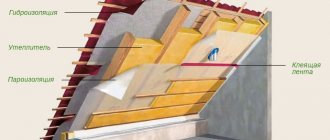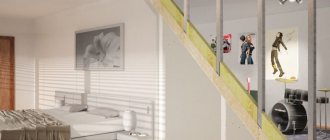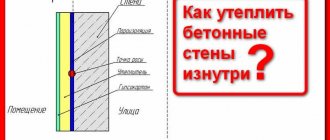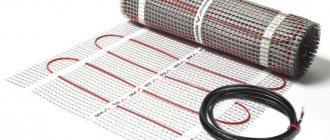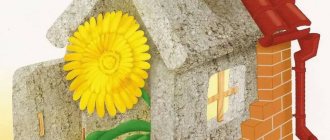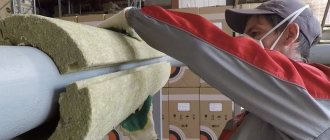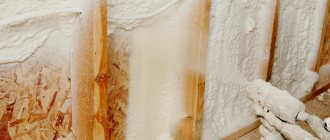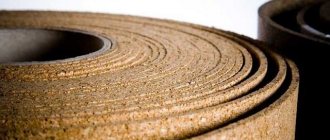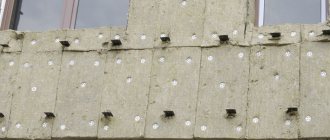When building a house, a lot of money is spent on its high-quality thermal insulation. But often all these expenses turn out to be in vain, and the reason for this is not always non-compliance with the technology of thermal insulation work, due to which the insulation gradually loses its properties. Often it is damaged by rodents, making through passages and holes in the warm “fur coat” and thereby opening the access of cold air to the walls and other structures. If you know which insulation is not chewed by mice and rats or how to protect it from them, these problems can be avoided.
The main rule of thermal insulation is the absence of cold bridges in the insulation Source domaleto.ru
Insulation of walls with reeds for thermal insulation of the room
The popularity of synthetic construction and finishing products has turned many houses and apartments into boxes stuffed with soulless plastic. This trend has given way to a fashion for natural materials that return the ecological warmth of nature to housing. Endless debates about whether insulating walls with mineral wool or expanded polystyrene can be harmful to human health do not concern the old-fashioned methods of protection from the cold. Who would worry about harmful chemicals in wood or straw? The abundance of thermal insulation materials in specialized stores did not prevent humanity from remembering such a wonderful plant as reeds, which are now successfully used for various purposes of decoration, construction and repair.
The main advantages of reed insulation: environmental friendliness, ease of installation, moisture resistance, minimal financial costs.
Properties of reeds as insulation
Thanks to its tubular structure, reeds provide thermal insulation as insulation in buildings at the proper level. An insulating layer 15-20 cm thick retains heat as effectively as laying a wall with one and a half bricks. In addition, reeds are characterized by good sound insulation - noise from the street will be practically inaudible.
If you make insulation from reeds,
it will not only retain heat, but will also allow air to pass through , allowing the room to “breathe.” It is not susceptible to destruction by fungi and microorganisms . rodents do not grow in such insulation , as they die upon contact with it.
Due to the low weight of the material, when insulated with reed reeds, the load on the foundation is minimal, which allows it to be widely used for construction purposes. Advantages of reed insulation:
- environmentally friendly material;
- high thermal insulation rates;
- dries quickly after getting wet;
- natural inexpensive material;
- does not get lost or cake due to the special structure of the stem;
- easy to install;
- provides good sound insulation.
WE CAN PRODUCE ANY REED MATS/PLATES TO YOUR ORDER
Reed has long been used to cover reed roofs, but today it has received a completely new “sound” thanks to such enthusiasts as Wood Head specialists.
To make reed mats, no synthetic additives are used; only reed stems are used, which are intertwined with metal wire. Needless to say, reed itself is an environmentally friendly material, the advantages of which make it almost ideal for finishing. Accordingly, mats made from it have the following properties:
- durability (the service life of such a roof is at least 50 years);
- rot resistance;
- excellent heat and sound insulation characteristics;
- resistance to shock loads;
- immunity to temperature changes;
- high installation speed;
- excellent aesthetic properties.
Mats made from reeds are:
- single-layer - the reeds are woven into one layer, with the width of the wire wrapping varying between 15-20 cm;
- multi-layered - the reeds are woven into several layers, and the width of the wire wrapping varies in the range of 25-30 cm.
The former are ideal for erecting decorative hedges and fences, and will also add zest to any interior. As for multilayer mats, they are ideal for covering roofs and carrying out thermal insulation work.
We supply both types of reed mats.
Areas of application of kamyshite
Reed and reed slabs are used in the construction of agricultural, residential and industrial buildings as insulation in external frame walls, partitions, floors and coverings:
It is not allowed in buildings with air humidity greater than 70% and in those building structures that can become humidified during operation.
In general, if you look at the advantages of reed insulation, it becomes clear that this material is suitable for building inexpensive and environmentally friendly houses.
Recommendations from professionals
Only fatty types of clay are suitable for forming insulation. A mixture that is too dry will crumble after drying and will not provide the required plasticity when wet. It’s easy to distinguish oily clay from dry clay: you need to squeeze the wet mixture in your fist - after unclenching, your fingers stick together a little, which means the clay is good.
Do not take the mixture from the bottom of reservoirs - there is a lot of silt there, which does not have compressive strength. The material can be checked this way: wet it, roll it into a ball and flatten it - if the clay has not changed color, but moisture appears on the surface, the mixture is good, but a change in shade indicates that there is plenty of silt here, it is better not to take such clay.
A high-quality mixture, rolled into a ball and crushed in a fist, will not fall off if you turn your palm up - the pieces will fall off slowly, leaving small fractions on your hand. And a thin rod of wet mixture wrapped around a finger will not tear - this indicates the elasticity of the raw material, which is also good when laying out insulation.
And the last piece of advice: if you squeeze a dry piece of high-quality clay, it will break into small fragments, which are crushed only under the blows of a hammer; such pieces do not crumble in your fingers.
House made of reeds and clay - how to build
Due to the characteristics of the material, only low-rise buildings are built with its use, but there are no restrictions on their area . This could be a house made of reeds 12 by 12 meters, a compact gazebo 2 by 2, a spacious mansion, or a small utility building. One option is to resort to the services of professionals, the other is to do all the work yourself, which does not require the use of equipment - it is enough to have some construction skills.
Step-by-step instructions for building a cottage from reeds:
- foundation construction - due to the lightness of the structures, a massive foundation is not required, a shallow option is possible;
- laying roofing felt, coating the foundation with hot bitumen;
- installation of the lower belt of the planks and its waterproofing;
- construction of a wooden frame from racks, fixed to the lower belt with through tenons, and to the upper belt - with blind ones, and horizontal clamping boards. Fastening with 125-150 mm nails is possible;
- the distance between the axes of the load-bearing posts is 1.3-2.5 m, determined based on the weight of the walls and roof, and the installation interval of the rafters. The distance between intermediate vertical elements is 0.65-1.0 m;
- pressure boards with a thickness of 16-20 and a width of 80 mm are mounted on one side of the frame to the racks, cutting to their level, in increments of 250-300 mm. This interval is due to the limited nailability of reed slabs, which can only be attached to wooden elements;
Installation of reed roofing
- installation of a rafter system with a minimum slope of 35°. The recommended type of construction is non-thrust with bottom tightening;
- installation of wooden lathing with a pitch of 250-300 mm for the roof. A 25 mm board or a 50x50 mm block can be used;
- laying sheaves of reeds begins from the lower edge of the roof. Several packages are fixed to the sheathing elements using stainless or galvanized steel wire, then secured horizontally with a metal rod;
- the sheaves, initially laid upward with “tassels”, are opened and leveled using a special brush to obtain a layer of 30-35 cm and whipped upward to give shape to the roof;
- filling the wall frame with slabs attached to the wood with nails, or sheaves of reeds with a diameter of 120-180 mm, followed by fixation with pressure boards for high-quality compaction. When using a two-layer filling, the fibers of the mats must be placed in different directions;
- installation of partitions using sheaves 100 mm thick;
Wall of a reed house
- plastering the walls on both sides with a clay composition with the addition of straw or lime, and their lower parts with cement to protect them from rodents. The solution is applied twice - first in a thick layer, then in a thinner layer.
Where can I get raw materials for manufacturing?
Raw materials for such mats are not so difficult to find. Especially if there is a pond, lake or river somewhere nearby. Due to their spongy stem structure, reed mats are very soft and warm. The collection of reeds for mats for construction purposes is done around September-October. The most important and important thing about reed mats is that they are made without the use of artificial and synthetic additives. To ensure a beautiful looking reed mat, you need to carefully select high-quality reeds.
Since reed mats are environmentally friendly, have a beautiful appearance, are long-lasting and do not absorb moisture, they can be used for construction purposes, furnishing homes and adding beauty to the design of a room or yard. Also, reed mats are perfect for creating gazebos, bar counters and display cases.
Single-layer and multi-layer boards
Reed mats can be single-layer or multi-layer. Single-layer ones are most often used as screens, partitions, wall or ceiling coverings. They can also be used as insulation for cellars, animal rooms or summer buildings. As the name itself suggests, they are woven in one layer, and the width is approximately 20 centimeters.
Multilayer reed mats consist of several layers of reed stems. The width of the weaving is approximately 25-30 centimeters. These reed mats are usually used to construct a canopy or roof.
We carefully look for shortcomings
Ideal insulation is just a utopia. Each individual case has its own disadvantages, and Kamka is no exception. There are quite a few disadvantages to this product:
- Poor efficiency. This material belongs to the insulation materials of medium thermal conductivity. This means that to create reliable protection from the cold, you will have to create a very thick layer. Kamka is 2 times less effective than polystyrene foam. In comparison with more modern materials (penoplex, basalt wool, etc.), the difference is even more noticeable. Therefore, such technologies are practically not used in cold countries.
Advice: for the southern regions such thermal insulation will be quite sufficient.
- Weak mechanical strength. Mats of this material tear very easily, as a result of which they immediately turn into dust. Collecting this mass will be extremely difficult and not very pleasant. Therefore, installation becomes a rather difficult task.
- Relatively heavy weight. If compared with the same polystyrene foam or penoplex, then models made from algae will be significantly inferior. The impressive weight not only complicates the installation process, but also forces the construction of a fairly strong frame.
- In its original form, algae insulation is practically not subject to combustion. However, after a few years (depending on average annual temperatures), it begins to dry out and practically loses this quality.
- The need to build a moisture-proofing layer. Most modern analogues are highly resistant to moisture.
Mineral wool
When deciding which insulation is better, many people choose this insulating material. Construction supermarkets offer users three types of this fiber insulator:
- glass wool;
- basalt wool, which includes mining waste;
- slag wool made from blast furnace melts.
This material has low thermal conductivity and is resistant to fungal growths and other biological organisms. Mineral wool is resistant to sudden temperature changes and is classified as non-flammable. It comes in the form of slabs or rolls, which are convenient to install on any surface.
Thermal insulation of the ceiling is effective, which can be done with the help of this material both from the inside and outside of the ceiling. In both options, it is necessary to install a vapor barrier at the bottom of the material, and a water barrier at the top. This will help rid the material of its main shortcomings:
- ability to absorb and accumulate moisture;
- evaporation of phenols, which may be part of the insulation.
Installation of mineral wool from the inside of the building is carried out on a pre-prepared sheathing, into the openings of which the material is installed. The frame is most often made of wood, but in some cases a galvanized profile can be used. The surface of the insulation is covered with a vapor barrier and finishing material. In the case of a bathhouse, this could be lining or other structures made of natural wood. You can learn more about the technology of insulating rooms with mineral wool by watching a step-by-step video.
The technology for installing this insulation from the attic side is the same as from the inside of the room. The only difference is the absence of lathing, since laying is done between the joists. In general, mineral wool can be laid on any surface, both in a frame bath and in a permanent brick structure.
When deciding how to insulate the walls in a bathhouse, you will definitely encounter the problem of choosing insulation. When purchasing a heat insulator, it is necessary to take into account its technical characteristics and standard sizes, environmental friendliness and fire safety.
Types of thermal insulation materials:
- Mineral (basalt) wool. The most popular version of the insulator, which promotes the best heat retention in the bathhouse. The new generation of mineral wool insulation is produced using not formaldehyde, but chemically neutral acrylic that does not emit toxic substances when heated.
- Peat blocks filled with sawdust and straw. They are characterized by bacterial static, non-flammability, and hygroscopicity.
- Foam glass. Environmentally friendly insulation that perfectly retains its performance properties over time, but is heavy in weight and expensive.
- Cork mats. They do not absorb moisture, do not deform, and retain heat well.
- Polyurethane foam boards. With aluminum coating on both sides. Used for insulation of Finnish baths.
- Expanded polystyrene, foam plastic. It is used as an insulator for insulating bathhouse walls from the outside, but not from the inside, because its destruction occurs at +60 degrees, and carcinogens are released.
- Natural insulation. Felt, wool, reeds, sawdust, moss, flax, straw, hemp - materials that have been used for insulation of Russian baths from time immemorial. It is not recommended to use it without special treatment to avoid rotting and damage by rodents.
What are the advantages of laying a reed roof?
- This is an environmentally friendly material, so when used even at high temperatures and humidity, it will not emit harmful chemicals. This is a win-win option for allergy sufferers and families with children.
- The solution is unique in terms of design and you are guaranteed to impress your guests. To see this, look at the photos of completed projects on our website.
- Since reeds and reeds are not afraid of moisture, you are not afraid of precipitation. Snow, hail, heavy rains - all this has no effect on the material. The liquid penetrates only 2-3 cm inside, but this is not dangerous.
- Air easily penetrates through the material, so the microclimate is not disturbed. This makes this solution stand out against the background of metal tiles.
- The service life reaches 50 years even when used in the harsh climate of the Russian Federation. This is the best choice in terms of price/quality ratio.
vote
Article rating
How is stem selection carried out?
As practice shows, the service life of roofing reeds depends 100% on the quality of the workpieces. When choosing a roof for your cottage, you need to select materials according to the following criteria:
- Stems with uneven coloring or cores with a spongy structure should not be used. The service life of these materials is minimal.
- Ideally, the age of reeds and reeds should not exceed 12 months, since otherwise there is a high probability of accumulation of harmful substances from the atmosphere.
- If you are interested in reed roofing for a building with complex architecture, look at photos of completed projects on our website. Since the stems are thin and flexible, reeds can be mounted on any structure - from gazebos to luxurious mansions.
- Traces of bacterial damage are unacceptable on the outer layer. If the material has been exposed to mold and fungi, it is not allowed for use.
- The diameter of the reeds should not exceed 8 millimeters and the length 2 meters.
After this, at the enterprise the material is treated with fire retardants on the outside and inside to avoid ignition during operation. Fire safety depends not only on the quality of fire retardants, but also on how the roof is laid with reeds. You can learn more from the video prepared by our team.
